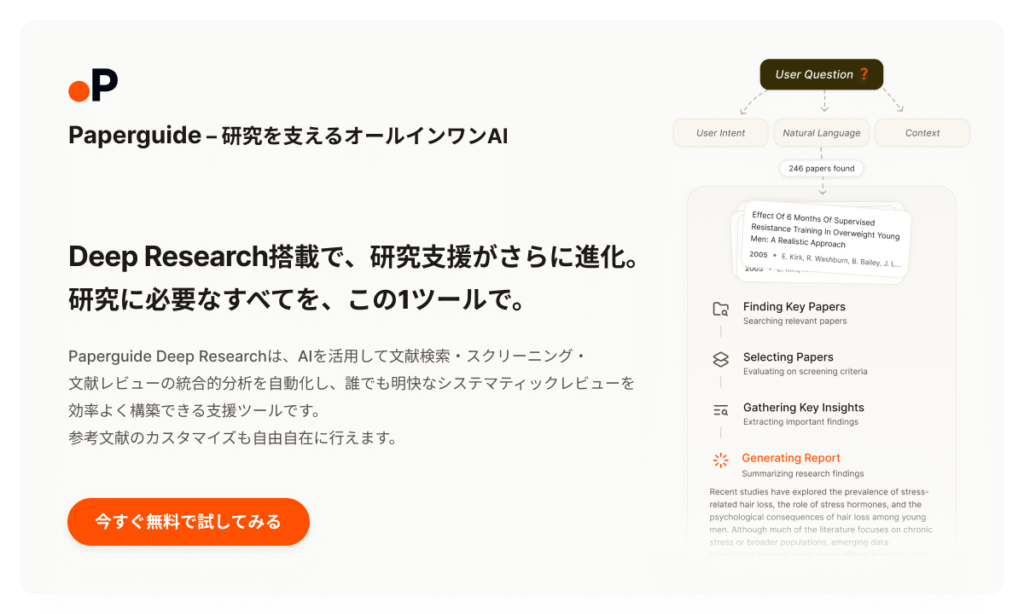In this issue, we will explain the tenure-track system.

What do "tenure-track assistant professor," "tenure-track lecturer," and other such professors mean at universities?

You may know the term "tenure track," but what exactly does it entail and what are its benefits?
This article will provide an overview of the process, and will also provide specificOpen recruitment methods, selection ratios, treatment, percentage of tenure, and issuesThe following is a detailed explanation of these and other topics.
\The point of this article/.
- Characteristics of the tenure-track system
- Attractiveness of the tenure-track system
- Pass rate for tenure review
You can read it from anywhere you like by clicking on it!
What are the features of the tenure-track system?

Here is a brief summary of Japan's tenure-track system in a nutshell.
A system that provides young researchers with a completely independent research environment and funding, and if they achieve the expected results within a certain period of time, they can obtain a stable position (tenure) with no fixed term.
Feature 1: For young researchers
The subject is a Ph.Within 10 yearsHe is a young researcher at the
Feature 2: Provides an environment for independent research as a principal investigator (PI)
Tenure-track faculty are hired primarily for a five-year term and are offered
- research funds (expenses)
- Self-supporting research space
- Assignment of graduate students to laboratories as primary supervisor
- Human support system (mentors)※(A system that supports the placement of and administrative support for the)
Experienced and knowledgeable faculty members, researchers, etc. who provide extensive advice and other support to tenure-track faculty members to enable them to acquire know-how on laboratory management so that they can conduct research independently during their track period, and to obtain external funding as the first researcher on their own. Faculty advisors (professors) who are experts in their fields.
As a Principal Investigator (PI) with these supports,Independent research environmentis prepared.
 Akanon
AkanonMoney!
Location!
Human Support!
Feature 3: Earn a tenure post if you pass the screening process.
After annual and mid-term evaluations during the tenure-track period, the tenure review will take place before the end of the tenure.
If you pass the examination, you can go to your own institution.without a fixed termGet a tenure postYou can do this.
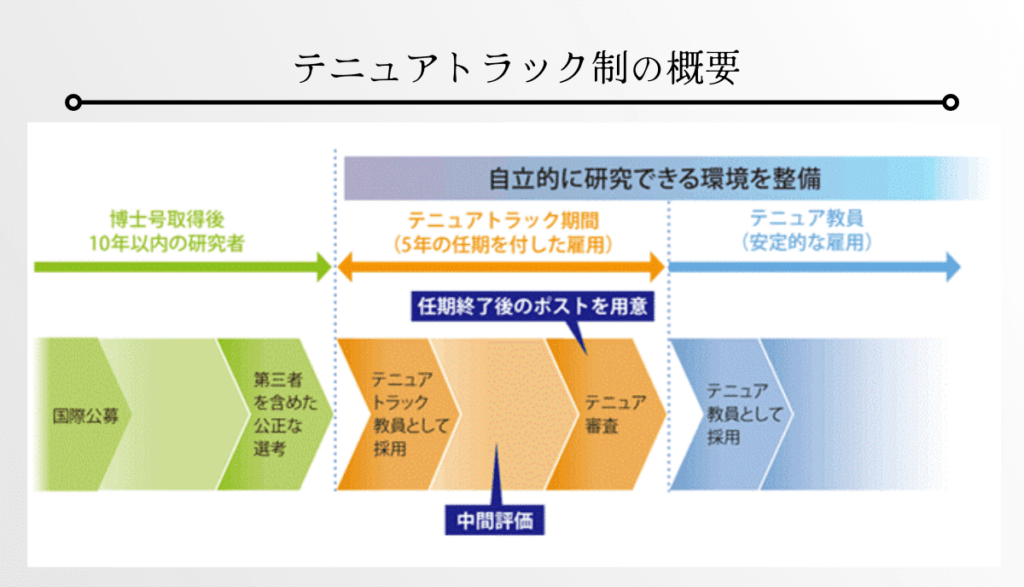
Also in tenure posts at that time,A Principal Investigator (PI) research environment must be assured.The company is committed to
In obtaining a tenure post, promotion is not considered absolute.
E.g., tenure-track assistant professor -> may become a tenured assistant professor.
Background of the emergence of the tenure-track system

Many researchers who have achieved outstanding research results have done the research that is the basis for their achievements at a young age.
The following chart shows the ages of the researchers at the time of the achievements that led to the Nobel Prize.
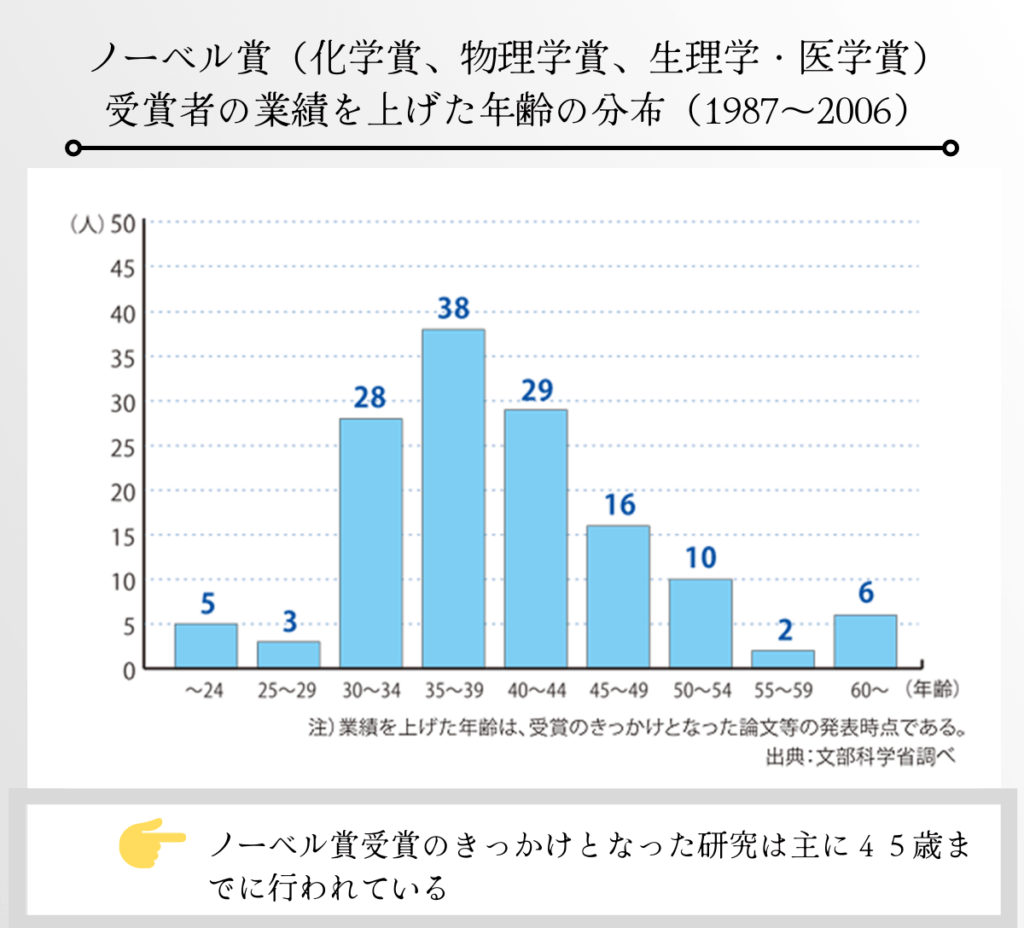
However, the research environment for young researchers in Japan today is not necessarily good.
The Ministry of Education, Culture, Sports, Science and Technology also raises this issue.
Many researchers who have achieved outstanding research results conduct the research that forms the basis of their achievements at a young age. However, many of Japan's young researchers are still in a situation where an environment that enables them to work independently has not been sufficiently developed. In addition, the recent reduction of basic expenses and total personnel costs at universities and independent research institutes has led to a decrease in the number of stable positions for young researchers, making it difficult for young researchers to envision their future prospects.
Adapted from "Program for Promotion and Establishment of Tenure-Track Program (Program to Promote Utilization of Advanced Approaches)," Science and Technology Policy Bureau, Ministry of Education, Culture, Sports, Science and Technology (MEXT), Japan.
 Akanon
AkanonToo much text from the Ministry of Education is exactly what it says.
The tenure-track system was introduced in 2011 in response to the need for a system that secures positions for young researchers after their tenure ends so that they can freely conduct research and foresee their future career paths.
Characteristics of open positions for tenure-track faculty

The details are left to each university, but the basic guidelines are provided by the Ministry of Education, Culture, Sports, Science and Technology (MEXT).
Characteristics of Public Selection (1): Fair and Transparent Selection
According to the Ministry of Education, Culture, Sports, Science and Technology (MEXT), the following are desirable in the recruitment and screening process for tenure-track faculty members.
- international recruitment
- The public application period is at least 2 months.
- Wide range of research fields
- Fair and transparent selection
- Include a third party outside the implementing agency as a member of the review committee.
- Performance evaluation by external experts
- Consideration that the percentage of recruits with no experience in other institutions is not too high (50% or less is desirable).
(Refer to the screening guideline for the program for promotion and establishment of tenure track (Program to promote utilization of advanced approaches), Science and Technology Policy Bureau, Ministry of Education, Culture, Sports, Science and Technology).
 Akanon
AkanonThe competitive ratio is very high because of the wide scope and long duration of the public offering. But the high level of transparency is ◎
Characteristics of Public Offering (2): fixed term of office
The term of office may vary from university to university, but a minimum of five years is preferred.
 Akanon
AkanonIf I am promised a five-year term of office, I can sit back and pursue my research.
Characteristics of Open Positions (3): Tenure review before the end of the term of office.
 Akanon
AkanonIf accepted for tenure review.Tenure positions without term limitsYou can become
The tenure review process includes
- Research Activities
- Achievements in obtaining external funding
- Patents and Intellectual Property Experience
- Educational Activities
This is done in compliance with the following points specified by the Ministry of Education, Culture, Sports, Science and Technology, depending on the criteria at each university, such as
- Fair and transparent screening
- Adding a third party outside the implementing agency as a review committee member
- Performance evaluation by external experts
- Exclude current and past research advisors and mentors from the entire review process
(Or, if a partial supervisor or mentor is included, there will be a separate review process that excludes the supervisor and will be a two-step review.)
(Refer to the screening guideline for the program for promotion and establishment of tenure track (Program to promote utilization of advanced approaches), Science and Technology Policy Bureau, Ministry of Education, Culture, Sports, Science and Technology).
What is the appeal of the tenure-track system for researchers?

Attractiveness 1: Independent research activities
What is the greatest attraction of the tenure-track system?Allowing young researchers to freely engage in research activities as Principal Investigators (PIs)。
With funding from the government and the university, you will be provided with a self-supporting laboratory as a principal investigator PI and given the expenses for running the laboratory (e.g., investment in experimental equipment, personnel expenses, research expenses, etc.).
 Akanon
AkanonYoung people can have their own laboratories.
Actual support amount
The chart below shows the average annual research expenses of researchers hired as tenure-track faculty.
In the first year of research funding, we willApprox. 10 millionand after the second year.4-6 millionsupport has been obtained (blue).
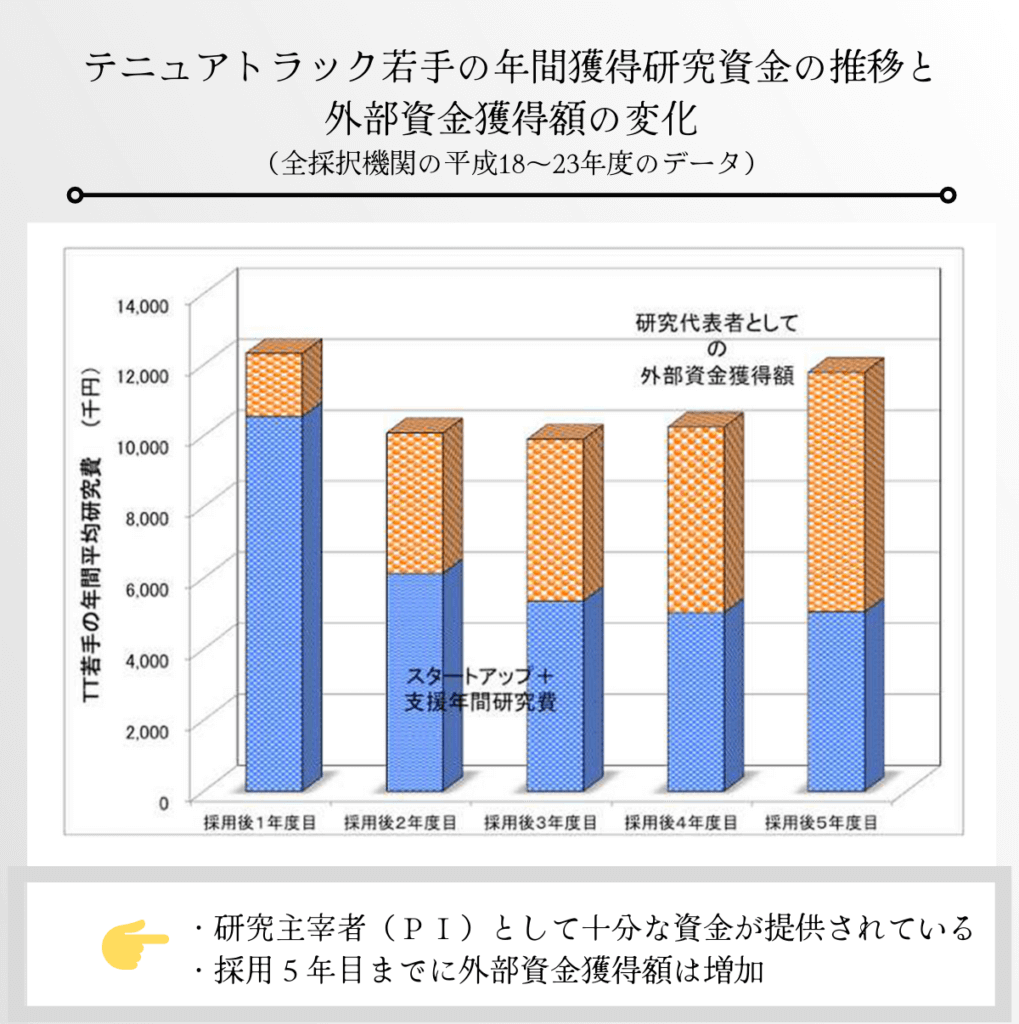
Attractiveness (2): An environment where research activities can be prioritized is taken into consideration.
If the tenure-track faculty member's total annual hours of work is 100% of his or herEfforts related to research activities must be at least 60%.is desirable.
(Refer to the "Guidelines for Publicly Inviting Applications for the Tenure Track Promotion and Establishment Project (Program for Promotion of Utilization of Advanced Approaches)", Science and Technology Policy Bureau, Ministry of Education, Culture, Sports, Science and Technology.
It is considered to be a
University faculty members have a variety of tasks in addition to their research activities, and the effort ratio of research activities tends to be small.
 Akanon
AkanonLectures, entrance exams, and so much more...
In order to create an environment in which they can concentrate on their research as much as possible, they seem to be able to be exempted from some of their non-research work.
Attractiveness 3: You can apply for a research area with a small research population.
If the research you are interested in is in an area with a small research population, it may be difficult to find an affiliation because there are no existing courses.
Particularly,Overseas lab experienceThere are many cases where there are no related courses when the "Mere Old Man" tries to return to Japan.
 Akanon
AkanonPoor brain circulation...
In order to avoid this situation, the open call for tenure-track faculty members has a wide range of research fields.
Attractiveness 4: Support system by mentor professors
The tenure-track system allows young researchers to have a laboratory as a research organizer (PI) at a treatment that would not normally be possible, but because of their limited experience, they may encounter difficulties in various aspects such as research activities and laboratory management.
To this end, faculty members who are close to the research area and have been selected will act as mentors to provide guidance and support.
 Akanon
AkanonI appreciate having an academic advisor to talk to.
Application rate for tenure-track faculty

Special Coordination Funds for Promoting Science and Technology According to the Program Evaluation Report (2012), the average application rate at the 21 institutions in place at the time was an average of20 timesIt is stated that the number of employees exceeded
In addition, the R2 year announcement by the Faculty of Science and Engineering at Waseda University showed that in response to the H24-27 openings for tenure-track faculty (10 total), there was a variation by department, but 2-50 applicants for each opening (average18.4 times(The application was received by the company. (TheWaseda University Tenure Track Promotion and Establishment Project: 5 Years of Activity Results Slide Report(R2 March))
tenure review

Each university has its own process for tenure review and the review itself, but here is a general outline of the process.
Steps to Screening
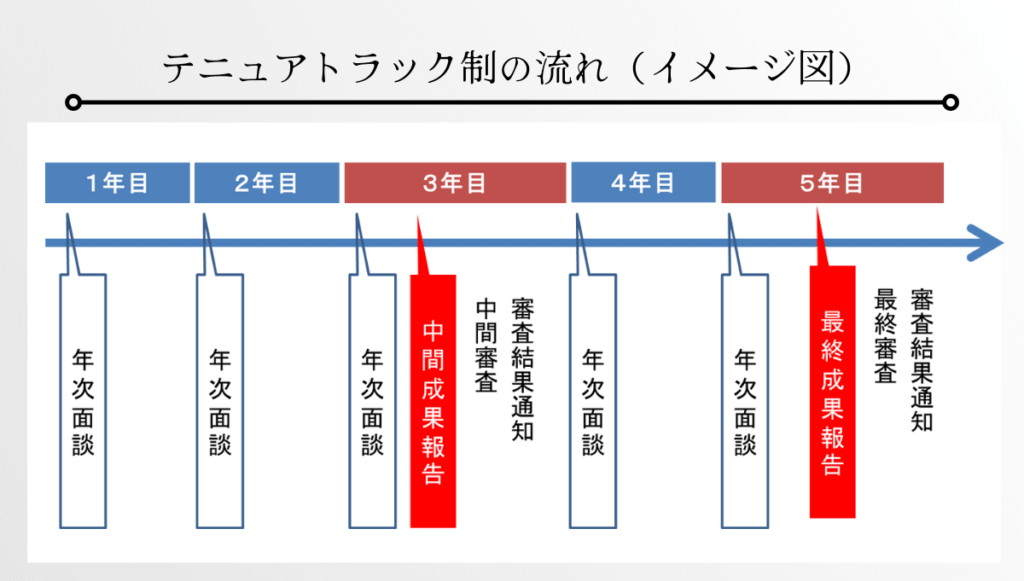
The flow of the tenure-track period varies from university to university, so please check with your university as appropriate.
Contents of Tenure Screening
Each university has its own set of evaluation criteria, which include the following
- Research Activities
- Achievement of the original research plan
- Advanced, originality, and future potential of future research plans (themes)
- Publication of papers, books, etc.
- Presentations at national and international conferences and invited presentations
- Various awards and recognitions
- Joint research with outside and inside the university
- Extramural collaborations such as funded research
- Achievements in obtaining external funding
- Experience in patent applications and intellectual property (software development)
- Educational Activities
- Content of Lectures and Instruction
- Results of Student Class Survey
- Qualities and aptitudes as a teacher (character, expression, leadership)
- Clear awareness (attitude, aspirations) as a teacher
And these reviews are conducted in a transparent manner, as follows
- Fair and transparent screening
- Adding a third party outside the implementing agency as a review committee member
- Performance evaluation by external experts
- Exclude current and past research advisors and mentors from the entire review process
(Or, if a partial supervisor or mentor is included, there will be a separate review process that excludes the supervisor and will be a two-step review.)
(Refer to the screening guideline for the program for promotion and establishment of tenure track (Program to promote utilization of advanced approaches), Science and Technology Policy Bureau, Ministry of Education, Culture, Sports, Science and Technology).
Pass rate for tenure review


What are the chances of being dropped from the tenure review process?
I looked for some material on the percentage of tenure that I was interested in and found it, although it is a bit old.
The pass rate for tenure review is approximately 80%.
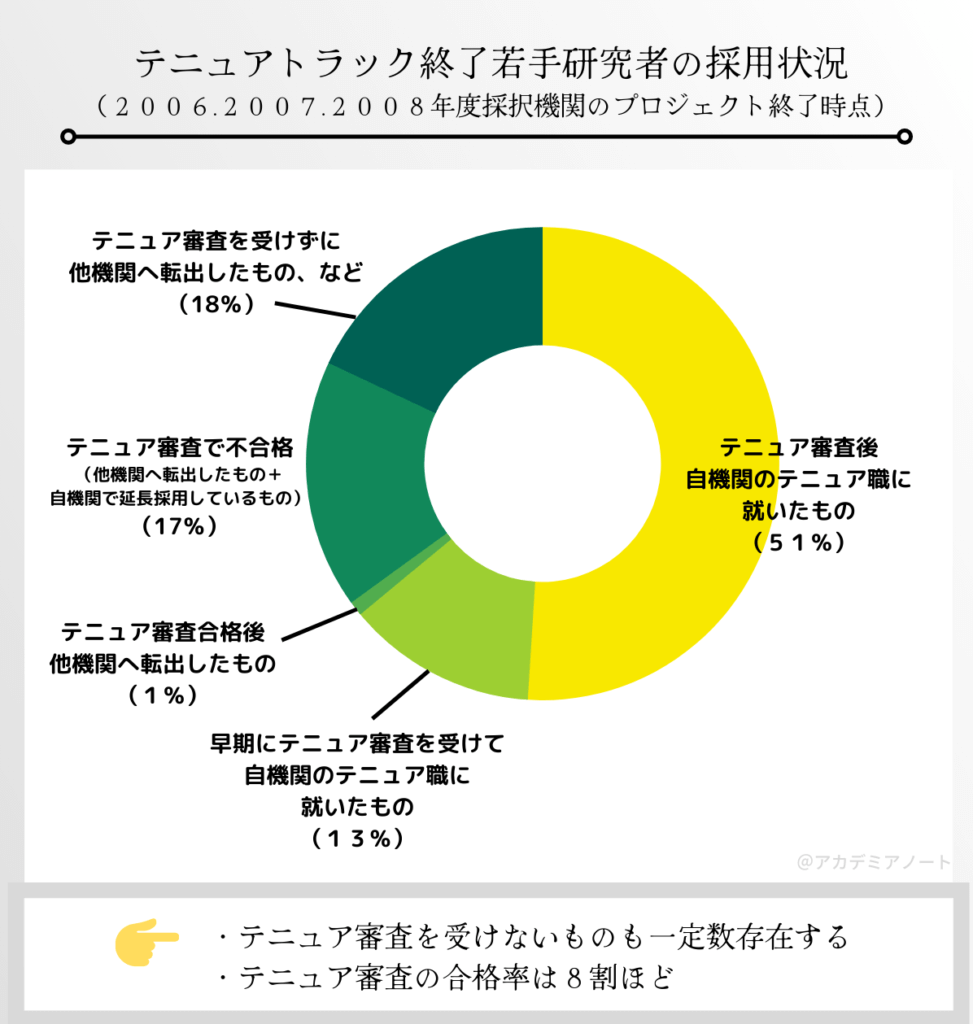
Prepared by the operator based on
(The figure above does not specify the number of people, but on another page it says "Tenure positions hired at own institution: 184 (/287)")
 Akanon
AkanonIf we exclude the 18% of "those who transferred to other institutions without undergoing tenure review," the pass rate for tenure review would be about 80%.
Other materials from Waseda University's School of Science and Engineering released in the R2 academic year are also introduced here, although the number of students is smaller.
Hired through the Tenure Track Promotion and Establishment Project since FY20124 out of 5 received tenure
(Two of them were tenured ahead of schedule.)
Waseda University Tenure Track Promotion and Establishment Project: 5 Years of Activity Results Slide Report(Adapted from (R2 March).
 Akanon
AkanonThis is also 80%.
Problems (issues) of the tenure-track system
The following problems (issues) emerged during MEXT's interviews with five institutions (University of Tokyo, Kyoto University, Nagoya University, Keio University, and Waseda University)(Implementation period: end of October to beginning of November 2014)
- Differences in perception of the definition and purpose of the tenure-track system by universities
- In the future, it should be clarified again what purpose and requirements the tenure-track system refers to in terms of personnel system.
- In the future, it should be clarified again what purpose and requirements the tenure-track system refers to in terms of personnel system.
- It will be difficult to find a job in the private sector if the student is removed from the tenure review process under the tenure-track system.
- Japan as a whole, including not only universities but also industry, must take steps to increase liquidity.
- Japan as a whole, including not only universities but also industry, must take steps to increase liquidity.
- The introduction of a tenure-track system may not be suitable depending on the academic system and personnel practices in the field.(For example, it is unsuitable for law schools, where the number of faculty members is fixed for each academic discipline, while substantial implementation is underway in medical schools, where many faculty members are transferred to hospitals and private companies.)
- Need a mechanism to implement a robust external review process for promotion from Associate Professor to Professor.
summary
In this issue, we summarize the tenure-track system.
- Ability to conduct independent research activities as a principal investigator
- Research space and funding are provided.
- If you pass the tenure review, you can get a tenure post.
- Apply in areas with small research populations
- Mentor support is available.
It will be a system with many advantages for researchers, such as
I look forward to seeing you again in another article.
 Akanon
AkanonPlease take a peek at our other articles.

